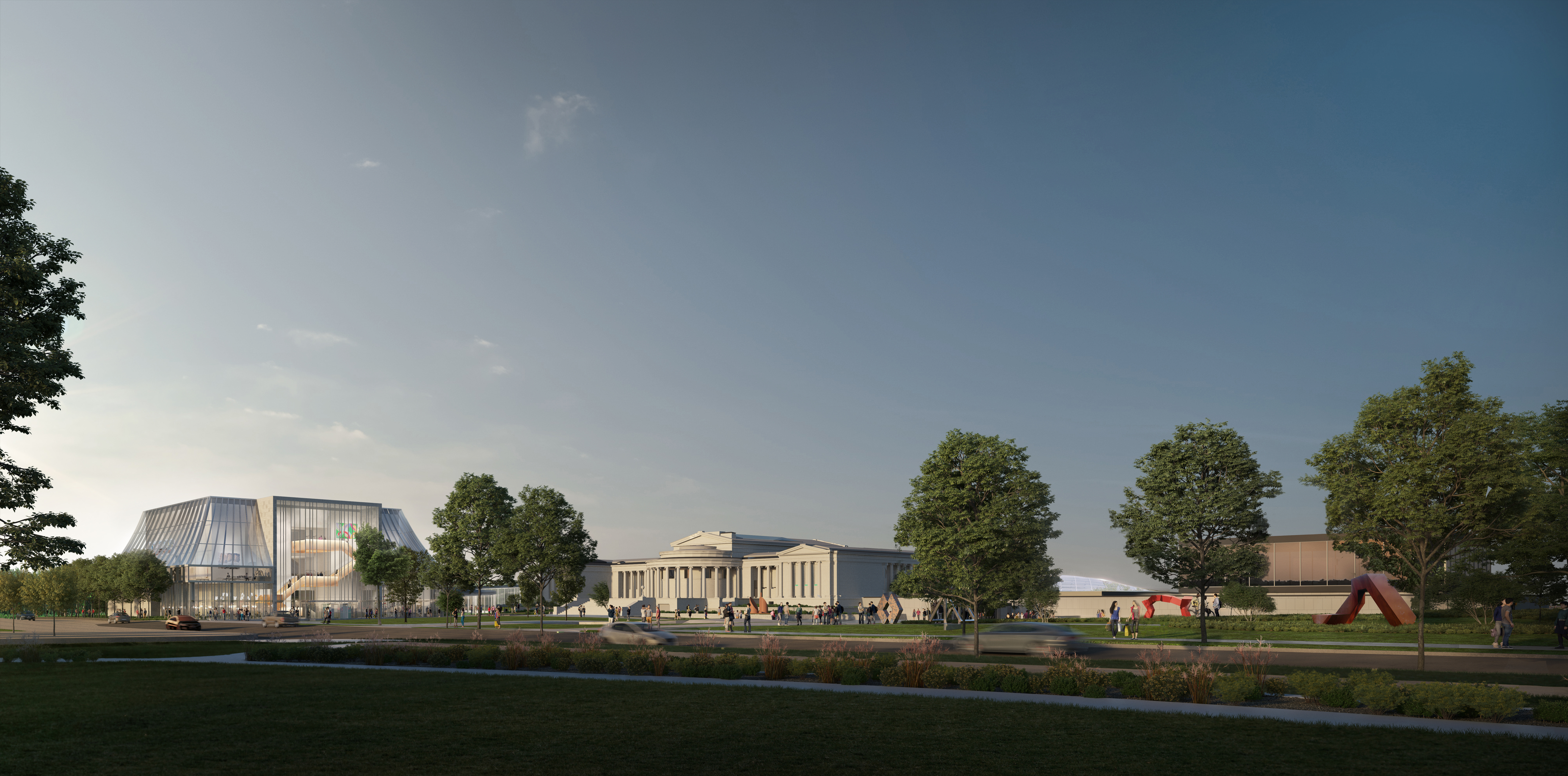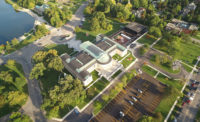Architects & Firms
Few cities in the United States boast as rich an assortment of architectural gems as Buffalo. Early American architectural styles can be traced backward from Frank Lloyd Wright to Louis Sullivan to H.H. Richardson. An idyllic park system designed by Frederick Law Olmsted and Calvert Vaux sprawls across the city. It’s even home to the sixth-oldest public art museum in the country, incorporated in 1862: the Albright-Knox Art Gallery, known today as the Buffalo AKG Art Museum. The first major exhibition of photography in the U.S. was held there, and pioneering collectors like Buffalo native A. Conger Goodyear made sure that the museum acquired impressive works by Cézanne, Picasso, and Gauguin. (Goodyear later cofounded and served as the first president of New York’s Museum of Modern Art.)
Space to display the museum’s collection did not always keep pace with acquisitions. Over its 161-year history, the institution has grown slowly but significantly. After a seven-year effort that included complex negotiations with municipal and state preservation groups, the Buffalo AKG has just completed its latest expansion: a new jewel-box addition designed by OMA partner Shohei Shigematsu, which is the firm’s first public art museum in the U.S.
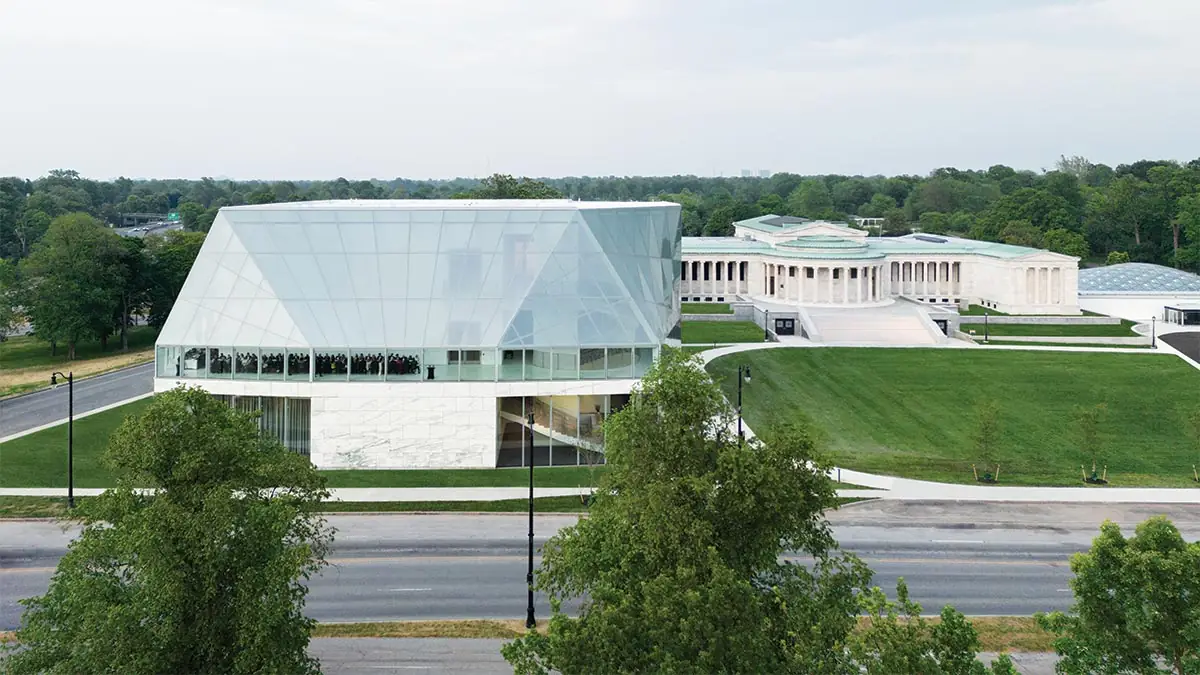
The new building sits on a plinth with transparent corners. Photo © Marco Cappelletti, click to enlarge.
Understanding the development of the museum’s campus is important in contextualizing OMA’s addition. The museum’s first permanent home, the gift of John J. Albright, had been designed at the turn of the century by local architect E.B. Green. Although construction delays foiled aspirations for the building to host exhibitions during Buffalo’s 1901 Pan-American Exposition, it was hailed as a Neoclassical paragon when it finally opened its doors four years later. This temple to the arts was dramatically sited atop a hill at the western edge of Olmsted’s Delaware Park, with a grand staircase leading up to its central pavilion. On either side were wings where eight caryatids, sculpted by Augustus Saint-Gaudens, could stand watch over Hoyt Lake.
The next significant addition came in 1962, when the museum opened a Modernist addition named for its benefactor, Seymour H. Knox, Jr. The architect was a Buffalo native who regularly strolled by as a kid: Skidmore, Owings & Merrill partner Gordon Bunshaft. The Knox addition consisted of a 236-by-113-foot marble-clad plinth that extended southward from the base of the adjoining building. Bunshaft carved an outdoor statuary court, square in plan, out of the plinth, which became a focal point for visitors accessing the museum via its new entry vestibule. To balance this void, a solid volume sheathed in black glass ascended from the plinth to form a square auditorium, with new galleries and a restaurant tucked underneath. Like its 1905 predecessor, Bunshaft’s addition epitomized its moment in history—here, a sleek International Style building. Tailored detailing aside, symmetries and proportions inextricably linked it to the adjoining Neoclassical neighbor. It was the “black diamond” to E.B. Green’s “white pearl.”
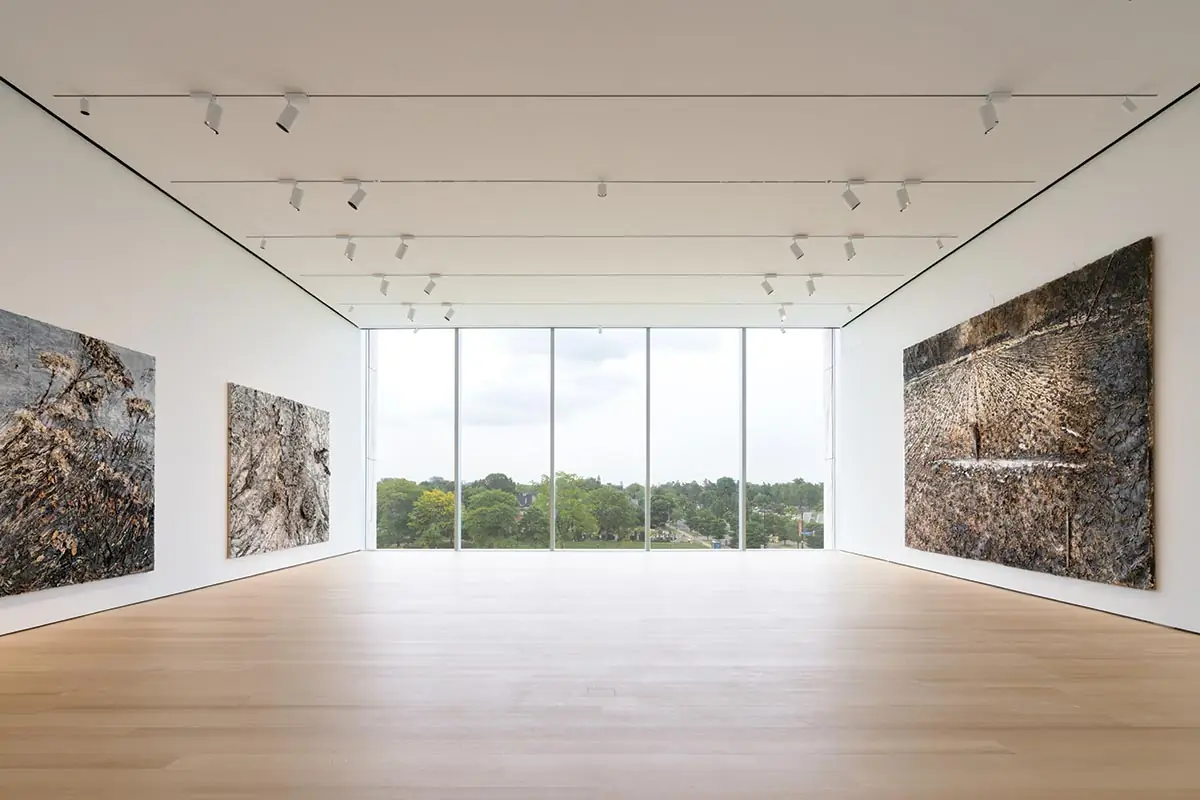
Downtown Buffalo is visible from the third floor. Photo © Marco Cappelletti
By the time Janne Sirén took the helm as director in 2013, the museum was ready to expand again. After surveying the work of 50 architectural practices, a committee shortlisted five firms—Allied Works (designer of the Clyfford Still Museum in Denver), Bjarke Ingels Group, Snøhetta (which had completed the museum’s 2012 master plan), OMA, and WHY—and asked them to respond to three different scenarios. Identifying the strongest design was not the aim of this exercise, Sirén points out: “Ultimately, we were interested in chemistry. We were also very specific about who we selected,” he adds regarding the museum’s decision to select OMA in June 2016. “It wasn’t Rem Koolhaas, but Shohei Shigematsu. There was great chemistry between his team and ours.” Design work on the new building began in earnest later that autumn, and the following summer the museum released an initial concept to the public.
OMA proposed radically transforming the courtyard of the Knox addition into an enclosed pedestrian thoroughfare, connecting Delaware Park and Elmwood Avenue with a pathway that would have taken visitors through an art-filled lobby. High above, supported on two massive piers, a new gallery floated above the rooflines of the two buildings on either side of it. But the scheme raised questions among preservationists, who were concerned about the heavy-handed treatment of a landmarked building. “We were criticized for not engaging a preservation architect earlier,” says Sirén. “I don’t want to be a Monday-morning quarterback, but I stand by what I said then—that this was OMA’s project to design. If we had added a preservation architect to Shohei’s side from the beginning, the creative dynamic between the staff here and his team would never have happened.”
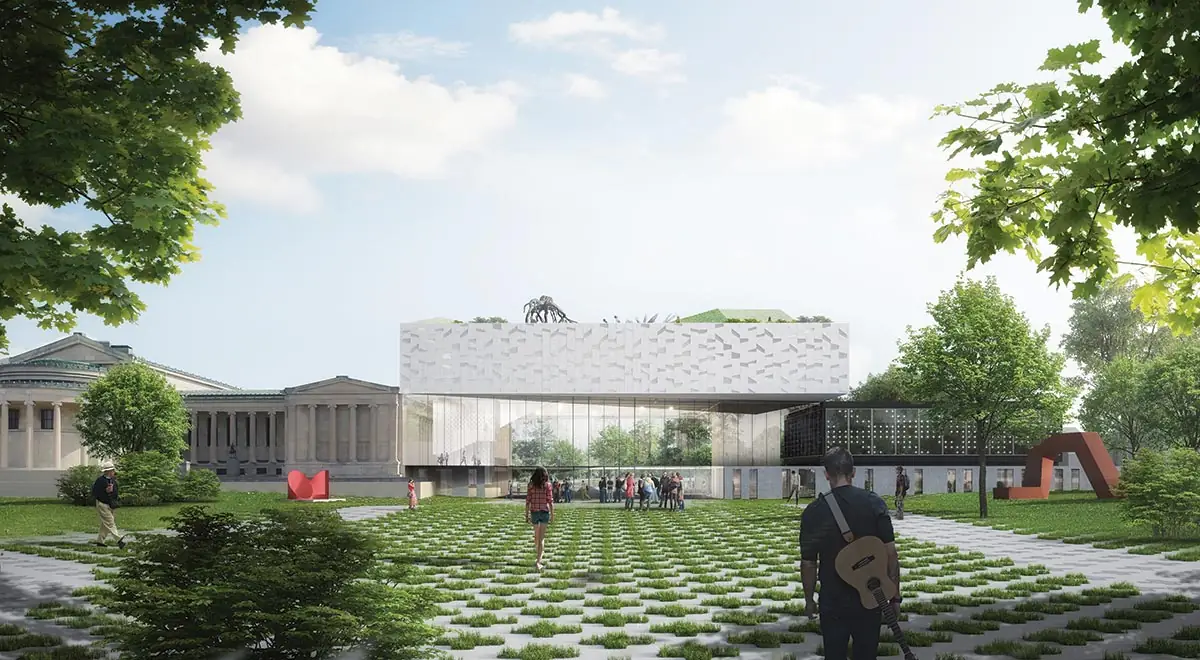
OMA’s original scheme, released to the public in 2017. Image © OMA
Shigematsu was dismissed by the locals as a “rank amateur” for attempting to tamper with Buffalo’s most beloved piece of postwar architecture. Some called for OMA’s dismissal from the project. However, many do not realize that Bunshaft had benefited from another architect’s failure. In 1957, board members had commissioned Pittsburgh-based Paul Schweikher to oversee the museum’s first expansion. His proposal, which would have replaced the park-facing grand staircase with a low-slung glass-and-stone plinth, 250 feet in length, was not enthusiastically embraced by locals. “May the spirit of John J. Albright haunt all those who have a hand in this dark deed,” quipped one disgruntled Buffalonian. Having witnessed the fallout, the best strategy to address a Neoclassical neighbor, Bunshaft said at the time, was to “leave it alone.” So he sited his addition where it couldn’t obstruct views of the 1905 building.
The museum never gave Schweikher a second chance, but it stood by OMA. After engaging preservationists and listening to the community, Shigematsu took a page out of Bunshaft’s book—shifting gears, weighing potential locations, and designing a freestanding building at the northwest corner of the museum’s campus. There, the new glass-and-marble-enclosed Jeffrey Gundlach Building stands boldly among its neighbors.
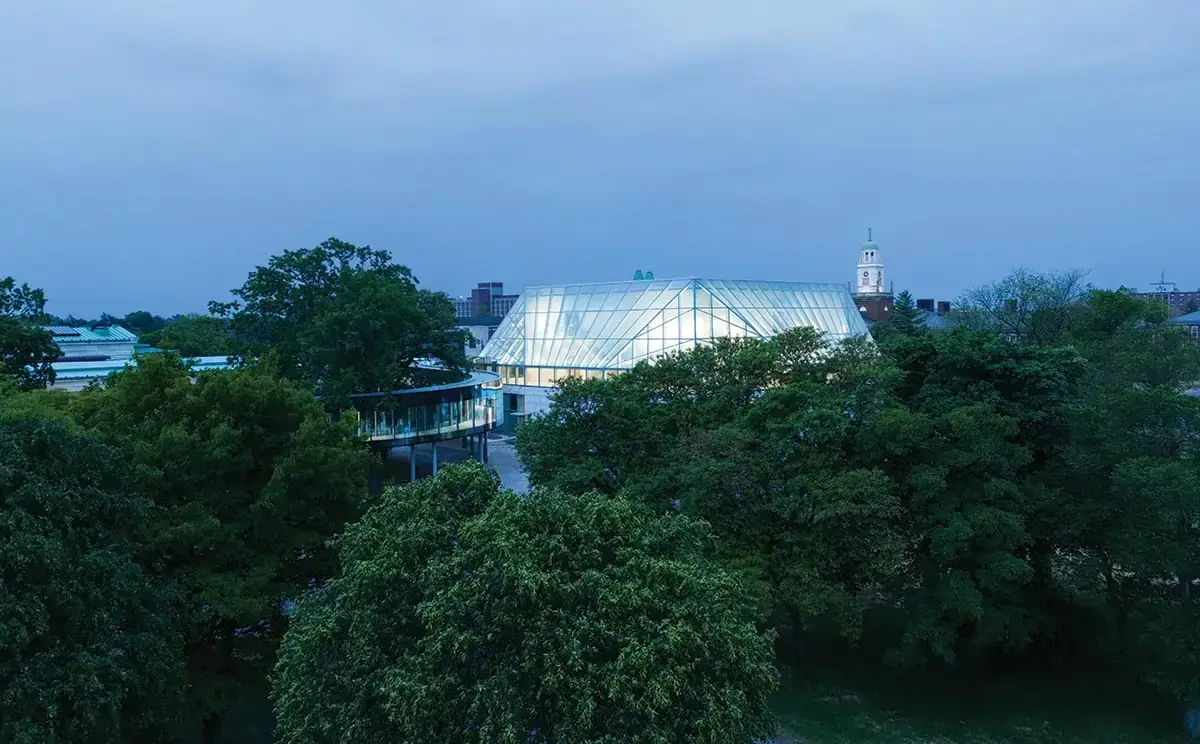
In the evening, the Gundlach Building glows. Photo © Marco Cappelletti
How does an architect add to a collection of buildings, each of which was so emblematic of its time? The once-familiar formula of Neoclassical shells filled with labyrinthine rooms has come and gone, as has the so-called Bilbao Effect. “Municipalities have gravitated toward ‘tents and events,’ like biennials and art fairs,” Shigematsu points out. The Gundlach Building thus combines the curator-preferred white-box galleries—enough to more than double the museum’s exhibition space—with a mix of flexible undefined and unprogrammed spaces well-suited to an institution that has taken a hands-on approach to community engagement.
Borrowing language from the original two buildings, OMA designed the addition to sit atop a plinth—in this case, one faced with marble sourced from the same quarry as the Knox addition, albeit with more graphic veining. A marble fascia also announces the monumental front entrance. Once inside, visitors make their way to a cruciform arrangement of galleries set within the square footprint of the building. “It’s plus-shaped because it’s an addition,” Shigematsu jokes, but the organization also recalls the classical symmetries of both the Green and the Bunshaft buildings. Rather than rely on service cores, 3-foot-6-inch-deep interior walls conceal m/e/p, while marble-clad portals elegantly mark the thresholds between galleries. In the four open corners of the plan, OMA has placed different programs, each treated with a different palette: a loading dock, fitted with aluminum panels for an industrial aesthetic; offices for staff, warmed with oak millwork; a media gallery, with soft surfaces; and a lobby, with a staircase that spirals toward the second and third floors.

1
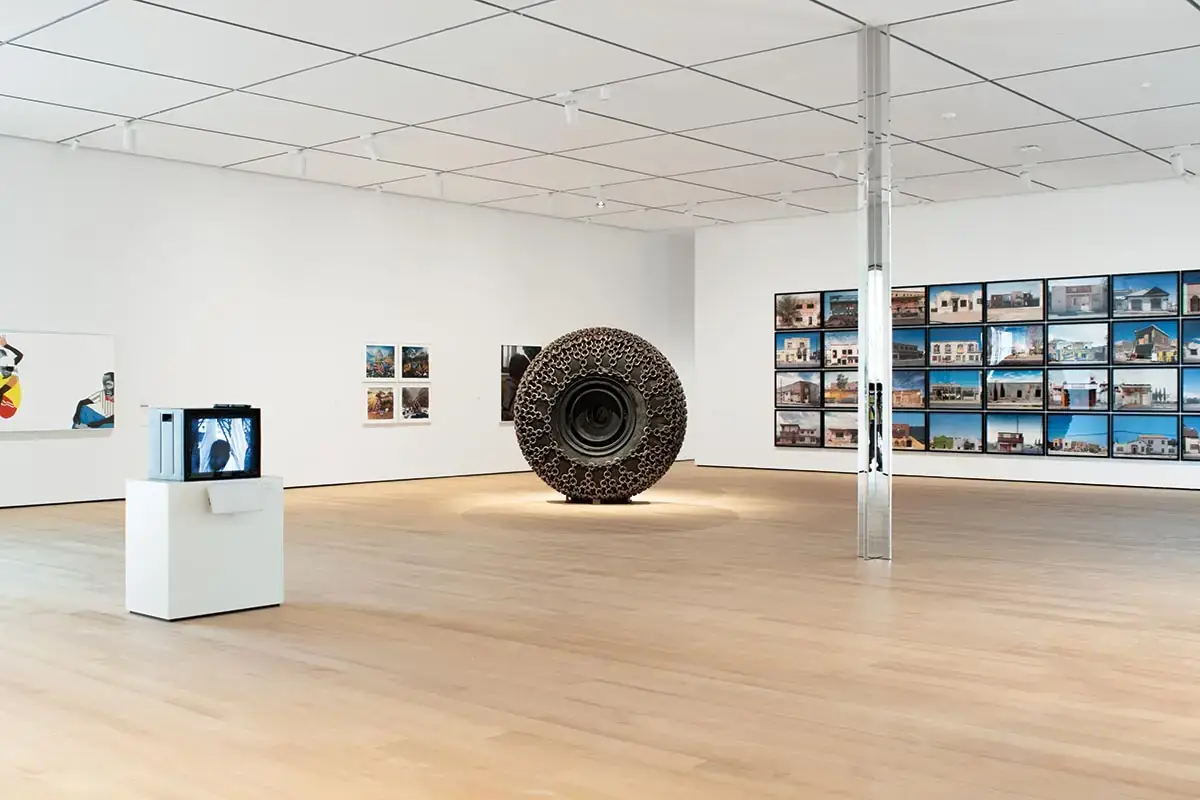
2
Galleries feature marble portals and slender cruciform columns (1 & 2). Photos © Marco Cappelletti
With each step upward, visitors might notice the floor’s terrazzo matrix gradually shifting from a warm pink to a neutral gray. Around the edges of the staircase, large marble chips artfully aggregate, and the supply grilles, also made of terrazzo, have been “stiletto proofed.” On upper floors, additional white-box galleries stack at the core of the building, creating a double-height terrace that wraps the perimeter of the building. This interstitial space is enclosed by fritted glass—taut and crystalline in some places, draped and veil-like in others. The diagrid supporting it all combines structural, electrical, and fire-safety systems, freeing up the white gallery walls for art or balconies, or to serve as a canvas for cross-hatched shadows on sunny days.
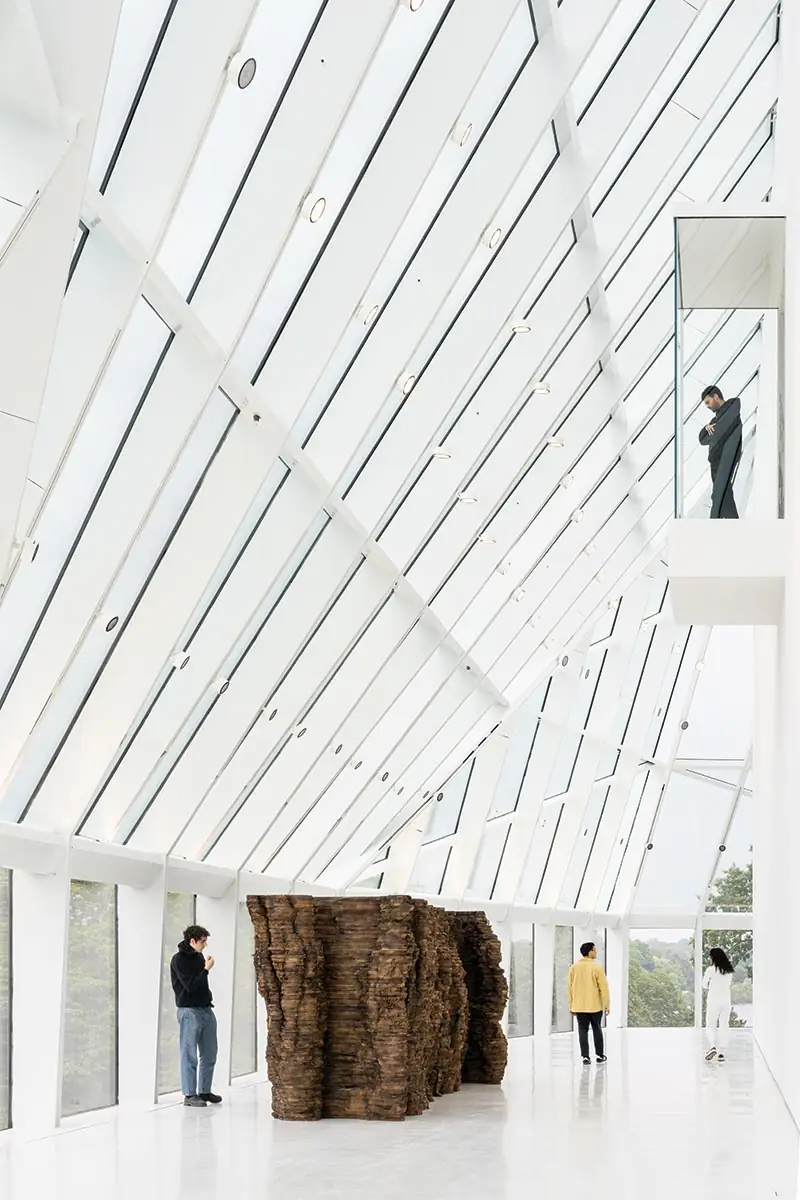
3
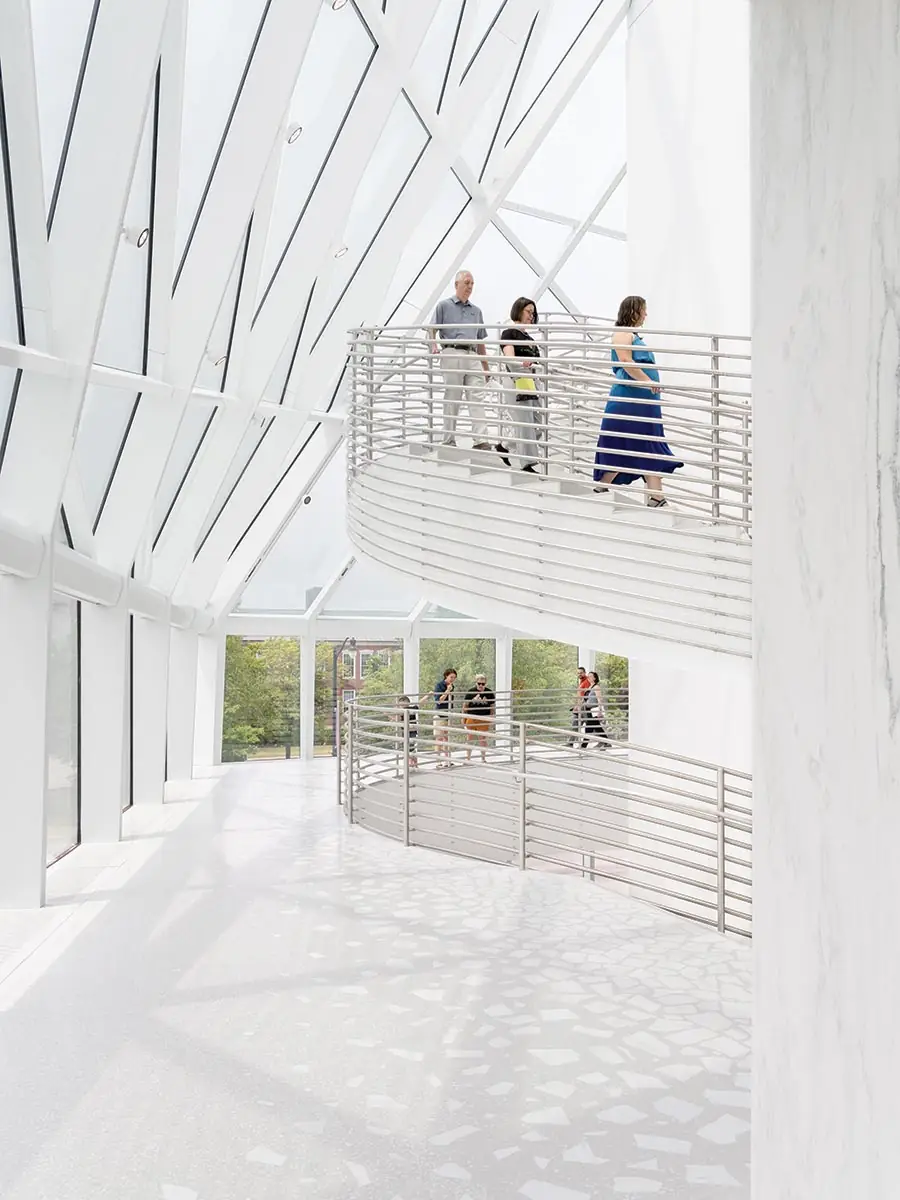
4
The sculpture terrace wraps around the upper-floor galleries of the Gundlach Building (3 & 4). Photos © Marco Cappelletti
On the second floor, an ADA-compliant, 10-foot-wide bridge snakes around an existing grove of oak trees to connect the Gundlach with Green’s 1905 building. The museum is now entirely accessible (and more porous, too, with four different entrances rather than one). But this bridge also solves a problem that has long plagued the institution: “Art museums need loading docks, and we’ve never had one,” Sirén explains. “Crating Picassos and Pollocks through Buffalo snowstorms is never ideal.” This new connection allows artworks to safely come and go through the Gundlach Building and move to any other part of the museum.
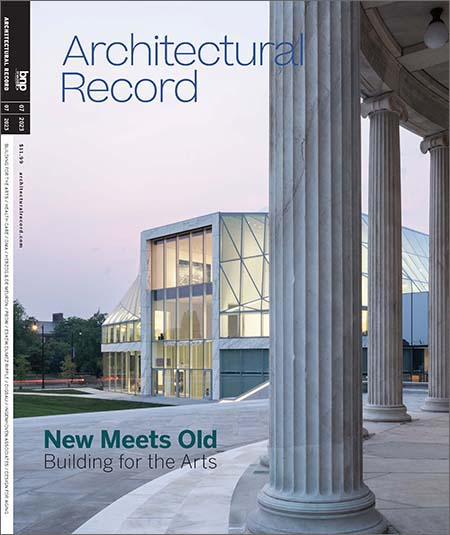
Photo © Marco Cappelletti
Financed by a $230 million capital campaign—the largest such campaign for a cultural institution in Western New York—the Buffalo AKG also rehabilitated its original two buildings. In the 1905 building, cracked marble floors were replaced with red oak to match those in Gundlach. Roofs were replaced, and interior finishes were repaired. Facing Elmwood Avenue, another grand staircase (previously razed by Bunshaft to make way for a parking lot) has been restored, and parking has been placed underground. It was a technically challenging endeavor, as executive architect Cooper Robertson senior associate Jason Cadorette points out: “We were working on three different buildings, from three different centuries, each with its own set of construction techniques.”
Despite the initial brouhaha over OMA’s original proposal, the museum continued its dialogue with the Buffalo Preservation Board and the New York State Historic Preservation Office to sensitively enclose the courtyard of the Knox addition (rendering it hospitable during harsh Buffalo winters) and to add a new entrance facing the park. Common Sky, a site-specific installation by artist Olafur Eliasson and architect Sebastian Behmann of Studio Other Spaces (SOS), now covers the space, which houses a café and adjoins new classrooms. Its tessellated glass skin, similar in ways to Gundlach’s, gently rises before falling asymmetrically into a funnel over a single point in the courtyard—where a tree once stood. Inside, alternating triangular acoustic panels, coated with a perforated reflective film, dampen sound and make for a dazzling effect that changes over the course of the day. Many joke that realizing Common Sky was made easier because it is an artwork and not architecture, but extensive structural upgrades were required to support snow loads. New beams were inconspicuously installed above original columns, which also had to be reinforced with piles that extend, in some cases, 60 feet down into bedrock.
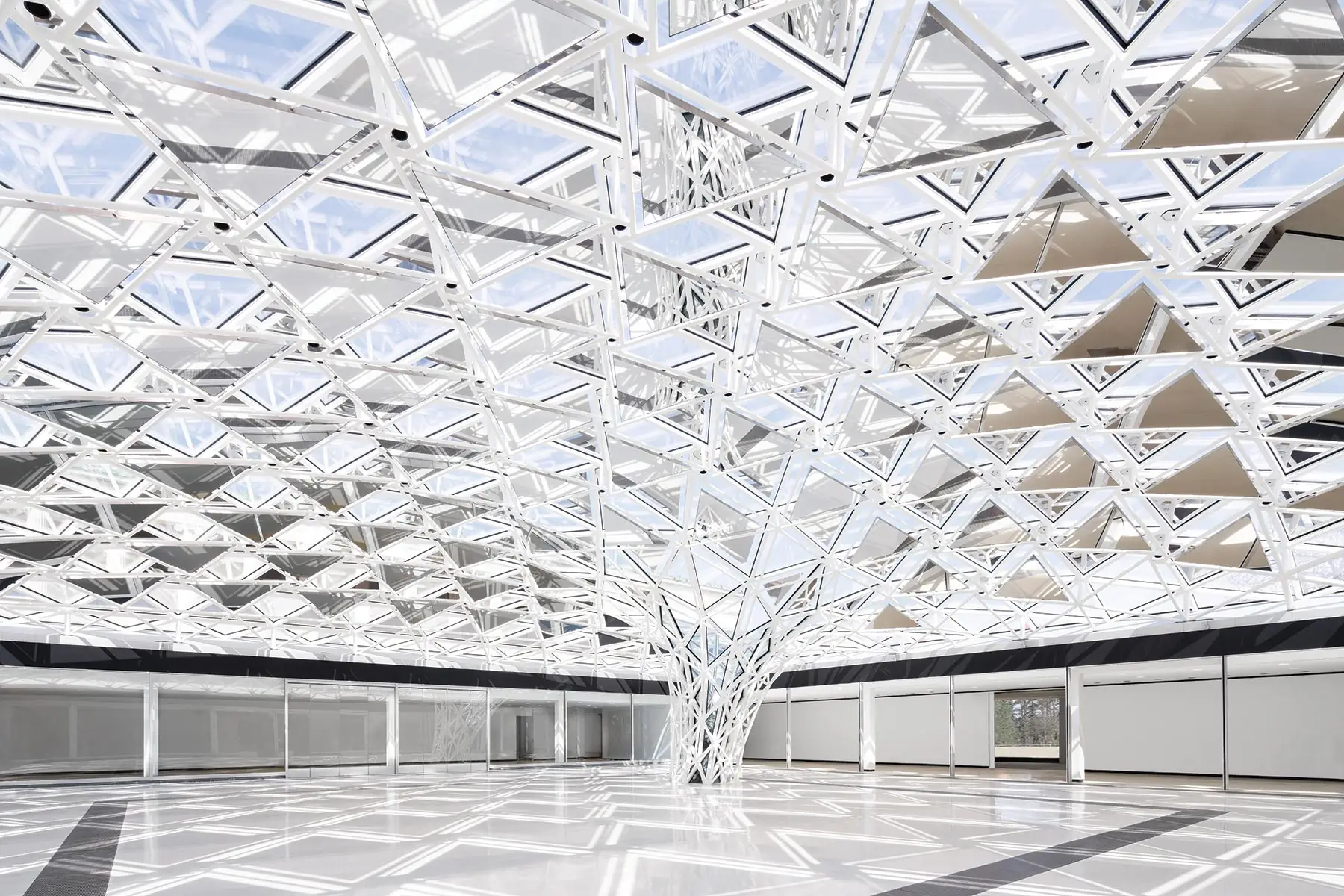
3
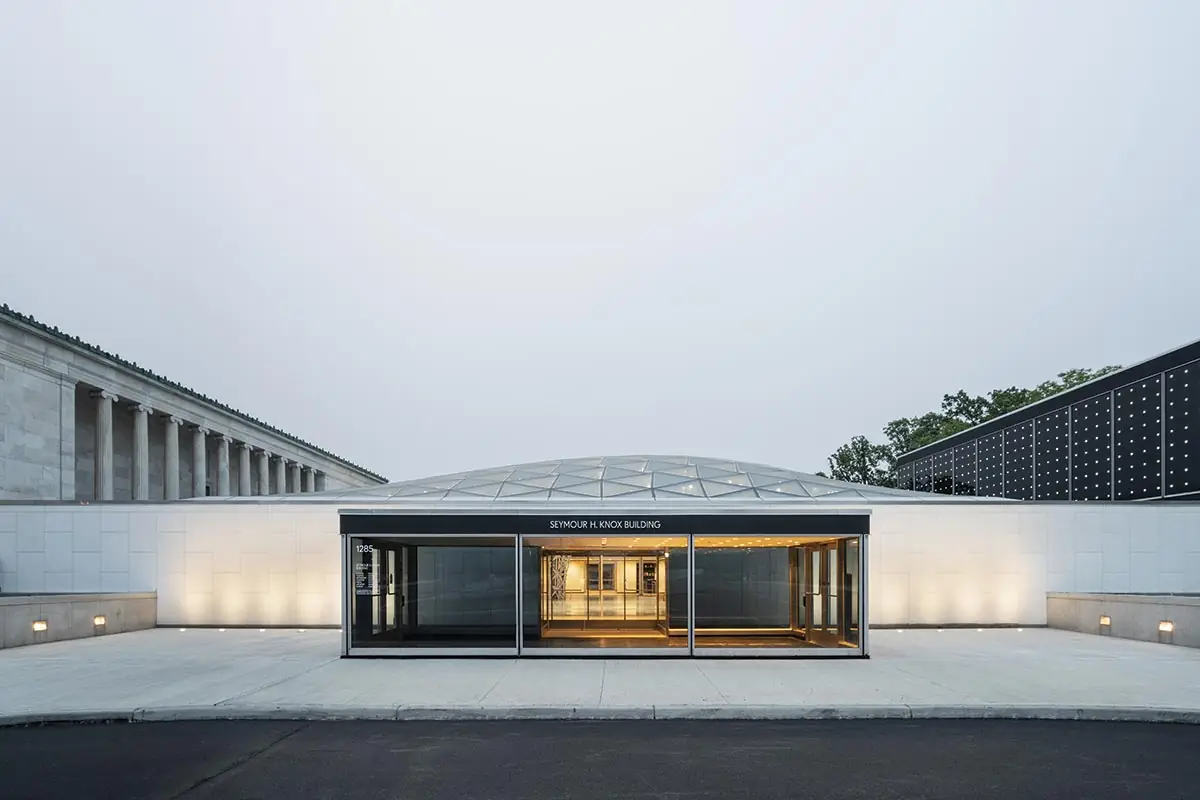
4
Common Sky (3) encloses the courtyard of the Knox addition (4). Photos © Marco Cappelletti
Perhaps OMA’s original proposal was a misstep; perhaps not building it was a missed opportunity. But the conversation that ensued brought constituents together, productively. “There are moments in the design that are conservative,” Shigematsu readily concedes, “but others that are experimental. It’s a mixture of language and ambition, and that’s what makes it contemporary.” The new building strikes a middle ground in that perennial tussle between architects and curators, between museums designed to showcase the works on display and those designed to be displays in and of themselves, and between serving the community and advancing institutional goals. It is humble, but also proud—and in a city that just experienced its first census growth in 70 years, the museum has positioned itself well to be a regional game changer.
Click plan to enlarge
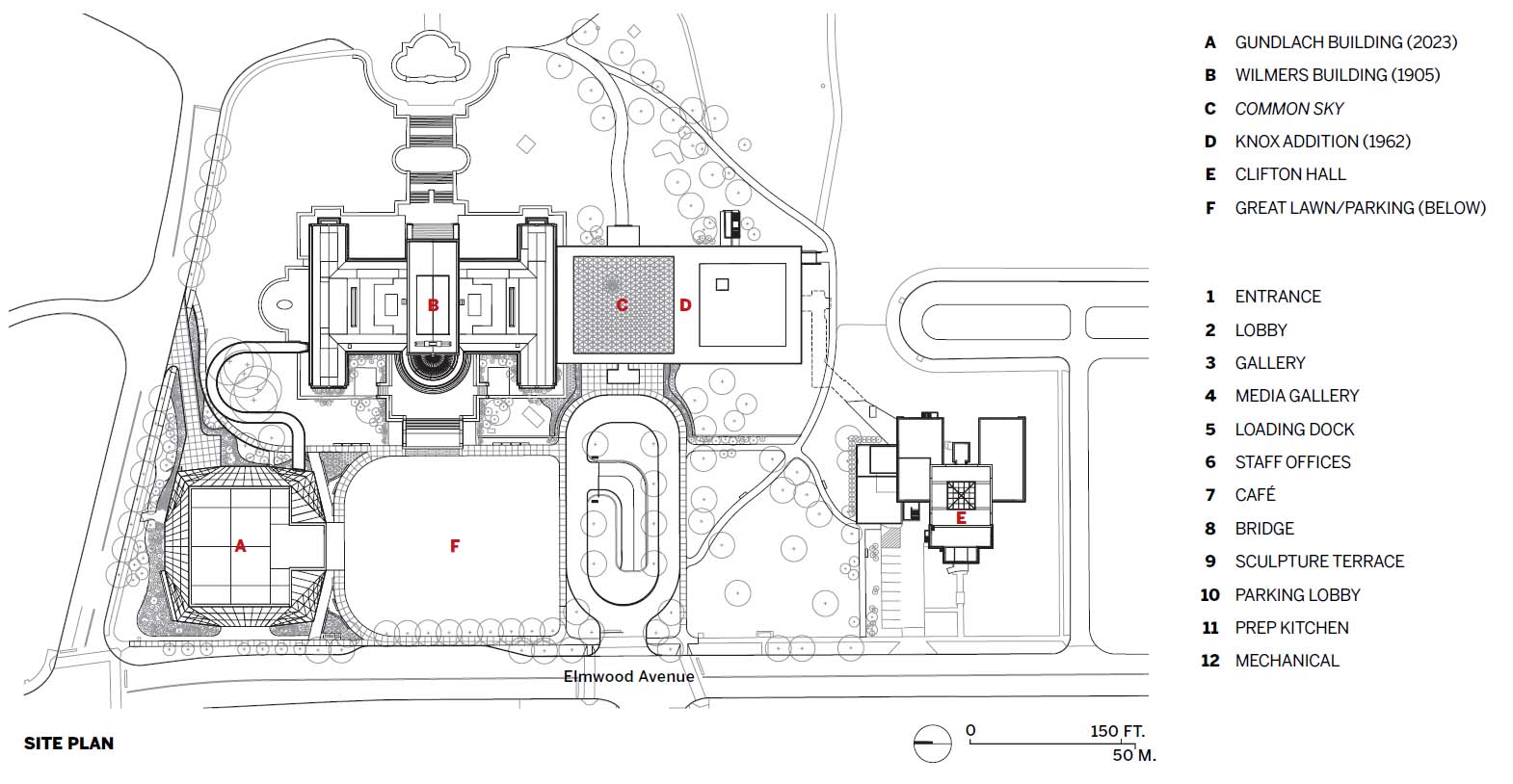
Click plan to enlarge

Click section to enlarge

Credits
Architect:
OMA — Shohei Shigematsu, partner; Lawrence Siu, Paxton Sheldahl, project architects
Executive Architect:
Cooper Robertson — Jason Cadorette, project manager; Erin Flynn, partner; Scott Newman, director
Engineers:
Arup (structural); Buro Happold (m/e/p); Wendel (civil); Thornton Thomasetti (facade/waterproofing); McMahon & Mann (geotechnical)
Consultants:
MVVA, Wendel (landscape); Litelab (lighting); Jaffe Holden (acoustics); Paul Battaglia (code); Preservation Studios (historic preservation)
General Contractor:
Gilbane
Client:
Buffalo AKG Art Museum
Size:
118,000 square feet (new); 28,300 square feet (renovation)
Cost:
$195 million
Completion Date:
July 2023
Sources
Masonry:
Vermont Quarries
Curtain Wall:
Roschmann Group with Buro Ehring Engineering
Glazing:
Glassbel
Doors:
Blasi (entrances); Steelcraft (metal doors); Overhead Door (upswinging doors)
Interior Finishes:
Armstrong (acoustical ceilings); Sherwin-Williams (paints/stains); Crane Composites (paneling); Formica (plastic laminate); 3 Form (special surfacing); Dal-Tile, Porcelanosa (floor/wall tile); Formglas (GFRG); Mohawk, Bentley (carpet)
Hardware:
Dorma (locksets)
Lighting:
Lutron (controls)
Plumbing:
Duravit, Lacava
Energy:
Colmac (heat pump); Schneider Electric Ecostructure (energy management)








